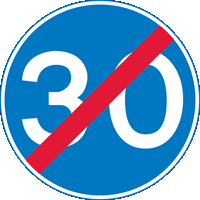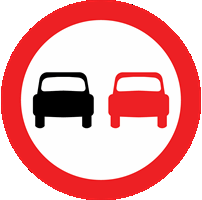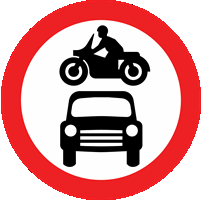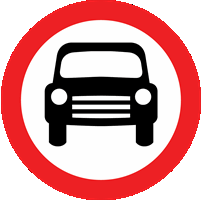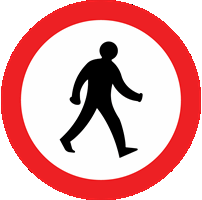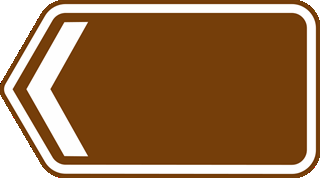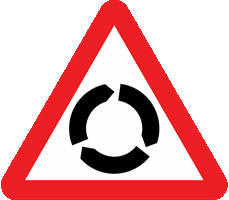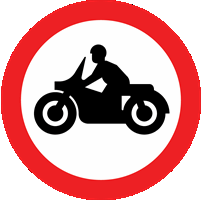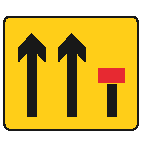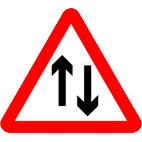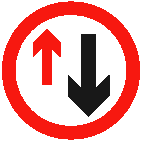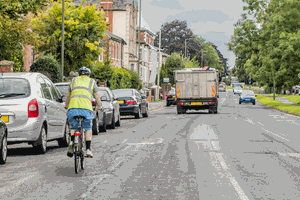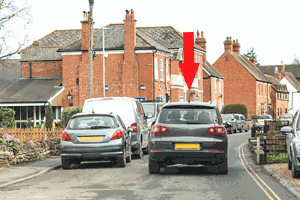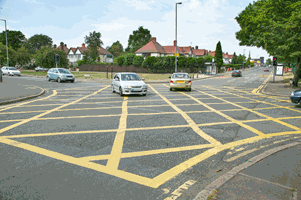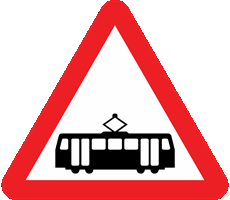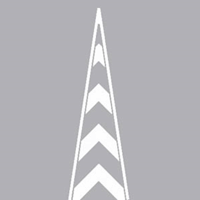
Car Mock Test 2
You have 57 minutes to answer 50 multiple choice driving theory test questions from the latest 2025 question bank. At least 43 out of 50 questions must be answered correctly in order to pass the test. Answers may be reviewed after each question or you can wait until the end of the test for your final score. Good luck!
Click on an answer to view the correct choice along with the explanation.
1. What's the minimum time gap you should leave when following a vehicle on a wet road?
Mark one answer
B
C
D
Correct Answer: A
Explanation: Water will reduce your tyres' grip on the road. The safe separation gap of at least two seconds in dry conditions should be doubled, to at least four seconds, in wet weather.
Explanation: Water will reduce your tyres' grip on the road. The safe separation gap of at least two seconds in dry conditions should be doubled, to at least four seconds, in wet weather.
Correct Answer: B
Explanation: The red slash through the sign indicates that the restriction has ended. In this case, the restriction was a minimum speed limit of 30 mph.
Explanation: The red slash through the sign indicates that the restriction has ended. In this case, the restriction was a minimum speed limit of 30 mph.
3. What should you do if you want to overtake a tractor but aren't sure that it's safe?
Mark one answer
B
C
D
Correct Answer: D
Explanation: Following a tractor can be frustrating, but never overtake if you're unsure whether it's safe. Ask yourself: 'Can I see far enough down the road to ensure that I can complete the manoeuvre safely?' It's better to be delayed for a minute or two than to take a chance that may cause a collision.
Explanation: Following a tractor can be frustrating, but never overtake if you're unsure whether it's safe. Ask yourself: 'Can I see far enough down the road to ensure that I can complete the manoeuvre safely?' It's better to be delayed for a minute or two than to take a chance that may cause a collision.
Correct Answer: B
Explanation: This sign is used to enable pedestrians to walk free from traffic. It's often found in shopping areas.
Explanation: This sign is used to enable pedestrians to walk free from traffic. It's often found in shopping areas.
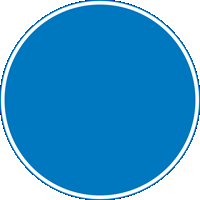
B
C
D
Correct Answer: B
Explanation: Signs with blue circles generally give mandatory instruction. These are often found in urban areas and include signs for mini-roundabouts and directional arrows.
Explanation: Signs with blue circles generally give mandatory instruction. These are often found in urban areas and include signs for mini-roundabouts and directional arrows.
Correct Answer: D
Explanation: Signs with a brown background give directions to places of interest. They're often seen on a motorway, directing you along the easiest route to the attraction.
Explanation: Signs with a brown background give directions to places of interest. They're often seen on a motorway, directing you along the easiest route to the attraction.
Correct Answer: D
Explanation: As you approach a roundabout, look well ahead and check all signs. Decide which exit you wish to take and move into the correct position as you approach the roundabout, signalling as required.
Explanation: As you approach a roundabout, look well ahead and check all signs. Decide which exit you wish to take and move into the correct position as you approach the roundabout, signalling as required.
Correct Answer: B
Explanation: This sign shows you that you can't get through to another route by turning left at the junction ahead.
Explanation: This sign shows you that you can't get through to another route by turning left at the junction ahead.
9. You see these double white lines along the centre of the road. When may you park on the left?
Mark one answer
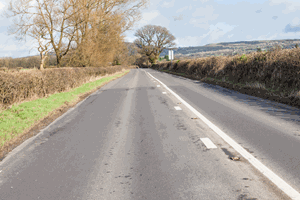
B
C
D
Correct Answer: C
Explanation: You mustn't park or stop on a road marked with double white lines (even where one of the lines is broken) except to pick up or set down passengers.
Explanation: You mustn't park or stop on a road marked with double white lines (even where one of the lines is broken) except to pick up or set down passengers.
Correct Answer: C
Explanation: Try to plan your journey so that you can take rest stops. It's recommended that you take a break of at least 15 minutes after every two hours of driving or riding. This should help to maintain your concentration.
Explanation: Try to plan your journey so that you can take rest stops. It's recommended that you take a break of at least 15 minutes after every two hours of driving or riding. This should help to maintain your concentration.
11. How should you position yourself when you use the emergency telephone on a motorway?
Mark one answer
B
C
D
Correct Answer: A
Explanation: Traffic is passing you at speed. If the draught from a large lorry catches you by surprise, it could blow you off balance and even onto the carriageway. By facing the oncoming traffic, you can see approaching lorries and so be prepared for their draught. You'll also be in a position to see any other hazards approaching.
Explanation: Traffic is passing you at speed. If the draught from a large lorry catches you by surprise, it could blow you off balance and even onto the carriageway. By facing the oncoming traffic, you can see approaching lorries and so be prepared for their draught. You'll also be in a position to see any other hazards approaching.
Correct Answer: D
Explanation: You must comply with all traffic signs and be especially aware of those signs that apply specifically to the type of vehicle you're using.
Explanation: You must comply with all traffic signs and be especially aware of those signs that apply specifically to the type of vehicle you're using.
13. You're on a motorway. A lorry has stopped in the right-hand lane. What should you do when you see this sign on the lorry?
Mark one answer
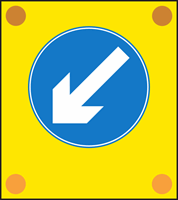
B
C
D
Correct Answer: C
Explanation: Sometimes work is carried out on the motorway without closing the lanes. When this happens, signs are mounted on the back of lorries to warn other road users of the roadworks ahead.
Explanation: Sometimes work is carried out on the motorway without closing the lanes. When this happens, signs are mounted on the back of lorries to warn other road users of the roadworks ahead.
Correct Answer: D
Explanation: Normally you should travel in the left-hand lane and only use the right-hand lane for overtaking or turning right. Move back into the left lane as soon as it's safe but don't cut in across the path of the vehicle you've just passed.
Explanation: Normally you should travel in the left-hand lane and only use the right-hand lane for overtaking or turning right. Move back into the left lane as soon as it's safe but don't cut in across the path of the vehicle you've just passed.
Correct Answer: C
Explanation: Even though you have priority, be prepared to give way if other drivers don't. This will help to avoid congestion, confrontation or even a collision.
Explanation: Even though you have priority, be prepared to give way if other drivers don't. This will help to avoid congestion, confrontation or even a collision.
16. Other drivers may sometimes flash their headlights at you. What's the official meaning of this signal?
Mark one answer
B
C
D
Correct Answer: D
Explanation: If other drivers flash their headlights, this isn't a signal to show priority. The flashing of headlights has the same meaning as sounding the horn: it's a warning of their presence.
Explanation: If other drivers flash their headlights, this isn't a signal to show priority. The flashing of headlights has the same meaning as sounding the horn: it's a warning of their presence.
B
C
D
Correct Answer: D
Explanation: If the road surface becomes very hot, it can soften. Tyres are unable to grip a soft surface as well as they can a firm dry one. Take care when cornering and braking.
Explanation: If the road surface becomes very hot, it can soften. Tyres are unable to grip a soft surface as well as they can a firm dry one. Take care when cornering and braking.
Correct Answer: C
Explanation: When following a cyclist, be aware that they have to deal with the hazards around them. They may wobble or swerve to avoid a pothole in the road or see a potential hazard and change direction suddenly. Don't follow them too closely or rev your engine impatiently.
Explanation: When following a cyclist, be aware that they have to deal with the hazards around them. They may wobble or swerve to avoid a pothole in the road or see a potential hazard and change direction suddenly. Don't follow them too closely or rev your engine impatiently.
Correct Answer: C
Explanation: These markings are found on the road outside schools. Don't stop or park on them, even to set down or pick up children. The markings are there to ensure that drivers, riders, children and other pedestrians have a clear view of the road in all directions.
Explanation: These markings are found on the road outside schools. Don't stop or park on them, even to set down or pick up children. The markings are there to ensure that drivers, riders, children and other pedestrians have a clear view of the road in all directions.
Correct Answer: A
Explanation: Although cars are the least likely to be affected, side winds can take anyone by surprise. This is most likely to happen after overtaking a large vehicle, when passing gaps between hedges or buildings, and on exposed sections of road.
Explanation: Although cars are the least likely to be affected, side winds can take anyone by surprise. This is most likely to happen after overtaking a large vehicle, when passing gaps between hedges or buildings, and on exposed sections of road.
21. The road is wet. Why would a motorcyclist steer around drain covers while they were cornering?
Mark one answer
B
C
D
Correct Answer: D
Explanation: Other drivers or riders may have to change course due to the size or characteristics of their vehicle. Understanding this will help you to anticipate their actions. Motorcyclists and cyclists will be checking the road ahead for uneven or slippery surfaces, especially in wet weather. They may need to move across their lane to avoid surface hazards such as potholes and drain covers.
Explanation: Other drivers or riders may have to change course due to the size or characteristics of their vehicle. Understanding this will help you to anticipate their actions. Motorcyclists and cyclists will be checking the road ahead for uneven or slippery surfaces, especially in wet weather. They may need to move across their lane to avoid surface hazards such as potholes and drain covers.
22. An injured motorcyclist is lying unconscious in the road. The traffic has stopped and there's no further danger. What could you do to help?
Mark one answer
B
C
D
Correct Answer: D
Explanation: If someone has been injured, the sooner proper medical attention is given the better. Ask someone to phone for help or do it yourself. An injured person should only be moved if they're in further danger. An injured motorcyclist's helmet shouldn't be removed unless it's essential.
Explanation: If someone has been injured, the sooner proper medical attention is given the better. Ask someone to phone for help or do it yourself. An injured person should only be moved if they're in further danger. An injured motorcyclist's helmet shouldn't be removed unless it's essential.
Correct Answer: D
Explanation: The motorcyclist is in an extremely vulnerable position, exposed to further danger from traffic. Approaching vehicles need advance warning in order to slow down and safely take avoiding action or stop. Don't put yourself or anyone else at risk. Use the hazard warning lights on your vehicle to alert other road users to the danger.
Explanation: The motorcyclist is in an extremely vulnerable position, exposed to further danger from traffic. Approaching vehicles need advance warning in order to slow down and safely take avoiding action or stop. Don't put yourself or anyone else at risk. Use the hazard warning lights on your vehicle to alert other road users to the danger.
Correct Answer: B
Explanation: If a young child has stopped breathing, first check that their airway is open and then begin CPR. With a young child, you may only need to use one hand and you shouldn't press down as far as you would with an adult. Continue the procedure until the child is breathing again or until a medical professional takes over.
Explanation: If a young child has stopped breathing, first check that their airway is open and then begin CPR. With a young child, you may only need to use one hand and you shouldn't press down as far as you would with an adult. Continue the procedure until the child is breathing again or until a medical professional takes over.
25. At an incident, a casualty isn't breathing. What should you do while helping them to start breathing again?
Mark one answer
B
C
D
Correct Answer: A
Explanation: It's important to ensure that the airway is open before you start CPR. To open the casualty's airway, place your fingers under their chin and lift it forward.
Explanation: It's important to ensure that the airway is open before you start CPR. To open the casualty's airway, place your fingers under their chin and lift it forward.
26. You're on a long motorway journey. What should you do if you start to feel sleepy?
Mark one answer
B
C
D
Correct Answer: B
Explanation: If you feel sleepy, you should leave the motorway at a service area or at the next exit and stop in a safe place to rest. A supply of fresh air can help to keep you alert before you reach the exit, but it isn't a substitute for stopping and resting.
Explanation: If you feel sleepy, you should leave the motorway at a service area or at the next exit and stop in a safe place to rest. A supply of fresh air can help to keep you alert before you reach the exit, but it isn't a substitute for stopping and resting.
Correct Answer: B
Explanation: If you're travelling on an icy road, extra caution will be required to avoid loss of control. Keeping your speed down and using the highest gear possible will reduce the risk of the tyres losing their grip on this slippery surface.
Explanation: If you're travelling on an icy road, extra caution will be required to avoid loss of control. Keeping your speed down and using the highest gear possible will reduce the risk of the tyres losing their grip on this slippery surface.
28. You intend to turn left at the traffic lights. What should you do just before turning?
Mark one answer
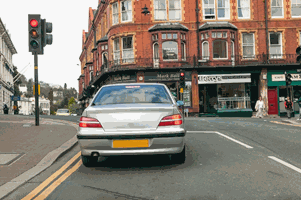
B
C
D
Correct Answer: A
Explanation: If you've been in a queue of traffic and are about to turn left, check your nearside for cyclists as they often filter past on the nearside of slow-moving or stationary vehicles.
Explanation: If you've been in a queue of traffic and are about to turn left, check your nearside for cyclists as they often filter past on the nearside of slow-moving or stationary vehicles.
Correct Answer: C
Explanation: If you feel yourself becoming tired or sleepy, you should leave the motorway at the next exit or services and stop for a rest. If you have to drive a long way, leave earlier and plan your journey to include rest stops. That way, you're less likely to become tired while driving and you'll still arrive in good time.
Explanation: If you feel yourself becoming tired or sleepy, you should leave the motorway at the next exit or services and stop for a rest. If you have to drive a long way, leave earlier and plan your journey to include rest stops. That way, you're less likely to become tired while driving and you'll still arrive in good time.
Correct Answer: D
Explanation: Long-distance driving can be boring. This, coupled with a stuffy, warm vehicle, can make you feel tired and sleepy. Make sure you take rest breaks to help you stay awake and alert. Stop in a safe place before you get to the stage of fighting sleep.
Explanation: Long-distance driving can be boring. This, coupled with a stuffy, warm vehicle, can make you feel tired and sleepy. Make sure you take rest breaks to help you stay awake and alert. Stop in a safe place before you get to the stage of fighting sleep.
31. You're driving at night. What should you do if you're dazzled by headlights coming towards you?
Mark one answer
B
C
D
Correct Answer: D
Explanation: If the headlights of an oncoming vehicle dazzle you, slow down or, if necessary, stop. Don't close your eyes or swerve, as you'll increase your chances of having a collision. Don't flash your headlights either, as this could dazzle other drivers and make the situation worse.
Explanation: If the headlights of an oncoming vehicle dazzle you, slow down or, if necessary, stop. Don't close your eyes or swerve, as you'll increase your chances of having a collision. Don't flash your headlights either, as this could dazzle other drivers and make the situation worse.
Correct Answer: C
Explanation: The speed limit for cars towing caravans or trailers on dual carriageways or motorways is 60 mph. Due to the increased weight and size of the combination, you should plan further ahead. Take care in windy weather, as a strong side wind can make a caravan or large trailer unstable.
Explanation: The speed limit for cars towing caravans or trailers on dual carriageways or motorways is 60 mph. Due to the increased weight and size of the combination, you should plan further ahead. Take care in windy weather, as a strong side wind can make a caravan or large trailer unstable.
33. You're driving on a busy main road. What should you do if you find that you're driving in the wrong direction?
Mark one answer
B
C
D
Correct Answer: C
Explanation: Don't turn around in a busy street or reverse from a side road into a main road. Find a quiet side road and choose a place to turn around where you won't obstruct an entrance or exit. Look out for pedestrians and cyclists as well as other traffic.
Explanation: Don't turn around in a busy street or reverse from a side road into a main road. Find a quiet side road and choose a place to turn around where you won't obstruct an entrance or exit. Look out for pedestrians and cyclists as well as other traffic.
34. You've broken down on a two-way road. You have a warning triangle. At least how far from your vehicle should you place the warning triangle?
Mark one answer
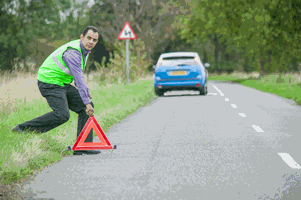
B
C
D
Correct Answer: C
Explanation: Advance warning triangles fold flat and don't take up much room. Use one to warn other road users if your vehicle has broken down or if there has been an incident. Place it at least 45 metres (147 feet) behind your vehicle (or the incident), on the same side of the road or verge. Place it further back if the scene is hidden by, for example, a bend, hill or dip in the road. Don't use warning triangles on motorways.
Explanation: Advance warning triangles fold flat and don't take up much room. Use one to warn other road users if your vehicle has broken down or if there has been an incident. Place it at least 45 metres (147 feet) behind your vehicle (or the incident), on the same side of the road or verge. Place it further back if the scene is hidden by, for example, a bend, hill or dip in the road. Don't use warning triangles on motorways.
B
C
D
Correct Answer: A
Explanation: If your vehicle breaks down on a level crossing, your first priority is to get everyone out of the vehicle and clear of the crossing. Then use the railway telephone, if there is one, to tell the signal operator. If you have time before the train arrives, move the vehicle clear of the crossing, but only do this if the alarm signals aren't activated.
Explanation: If your vehicle breaks down on a level crossing, your first priority is to get everyone out of the vehicle and clear of the crossing. Then use the railway telephone, if there is one, to tell the signal operator. If you have time before the train arrives, move the vehicle clear of the crossing, but only do this if the alarm signals aren't activated.
Correct Answer: B
Explanation: If you don't have your vehicle serviced regularly, the engine will gradually become less efficient. This will cause increased fuel consumption and, in turn, an increase in the amount of harmful emissions it produces.
Explanation: If you don't have your vehicle serviced regularly, the engine will gradually become less efficient. This will cause increased fuel consumption and, in turn, an increase in the amount of harmful emissions it produces.
37. You're driving on a one-way street. What should you do if you realise you've taken the wrong route?
Mark one answer
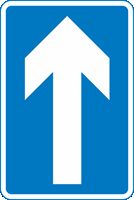
B
C
D
Correct Answer: A
Explanation: Never reverse or turn your vehicle around in a one-way street. It's illegal and could even cause a collision. If you've taken a wrong turn, carry on along the one-way street and find another route, checking the direction signs as you drive. Stop in a safe place if you need to check a map.
Explanation: Never reverse or turn your vehicle around in a one-way street. It's illegal and could even cause a collision. If you've taken a wrong turn, carry on along the one-way street and find another route, checking the direction signs as you drive. Stop in a safe place if you need to check a map.
38. Your vehicle has broken down on a motorway. What should you do if you aren't able to get onto the hard shoulder?
Mark one answer
B
C
D
Correct Answer: D
Explanation: If you can't get your vehicle onto the hard shoulder, use your hazard warning lights to warn others. Leave your vehicle only when you can safely get clear of the carriageway. Don't try to repair the vehicle or attempt to place any warning device on the carriageway.
Explanation: If you can't get your vehicle onto the hard shoulder, use your hazard warning lights to warn others. Leave your vehicle only when you can safely get clear of the carriageway. Don't try to repair the vehicle or attempt to place any warning device on the carriageway.
Correct Answer: D
Explanation: The registered keeper of the vehicle is responsible for paying the vehicle tax or making a Statutory Off-Road Notification (SORN) if the vehicle is to be kept untaxed and off the road.
Explanation: The registered keeper of the vehicle is responsible for paying the vehicle tax or making a Statutory Off-Road Notification (SORN) if the vehicle is to be kept untaxed and off the road.
40. What circumstances require you to notify the Driver and Vehicle Licensing Agency (DVLA)?
Mark one answer
B
C
D
Correct Answer: C
Explanation: DVLA holds the records of all vehicles, drivers and riders in Great Britain and Northern Ireland. They need to know if you have a medical condition that might affect your ability to drive safely. You must tell them if your health deteriorates and you become unfit to drive.
Explanation: DVLA holds the records of all vehicles, drivers and riders in Great Britain and Northern Ireland. They need to know if you have a medical condition that might affect your ability to drive safely. You must tell them if your health deteriorates and you become unfit to drive.
Correct Answer: A
Explanation: Rear fog lights make it easier to spot a vehicle ahead in foggy conditions. Avoid the temptation to use other vehicles' lights as a guide, as they may give you a false sense of security.
Explanation: Rear fog lights make it easier to spot a vehicle ahead in foggy conditions. Avoid the temptation to use other vehicles' lights as a guide, as they may give you a false sense of security.
Correct Answer: B
Explanation: Whenever possible, leave your car in a secure car park. This will help deter thieves.
Explanation: Whenever possible, leave your car in a secure car park. This will help deter thieves.
B
C
D
Correct Answer: A
Explanation: Your brake lights will give an indication to traffic behind that you're slowing down. Good anticipation will allow you time to check your mirrors before slowing.
Explanation: Your brake lights will give an indication to traffic behind that you're slowing down. Good anticipation will allow you time to check your mirrors before slowing.
Correct Answer: A
Explanation: A security-coded radio can deter thieves, as it's likely to be of little use when removed from the vehicle.
Explanation: A security-coded radio can deter thieves, as it's likely to be of little use when removed from the vehicle.
45. You're driving on an open road in dry weather. What distance should you keep from the vehicle in front?
Mark one answer
B
C
D
Correct Answer: A
Explanation: One way of checking there's a safe distance between you and the vehicle in front is to use the two-second rule. To check for a two-second time gap, choose a stationary object ahead, such as a bridge or road sign. When the car in front passes the object, say 'Only a fool breaks the two-second rule'. If you reach the object before you finish saying the phrase, you're too close and need to increase the gap.
Explanation: One way of checking there's a safe distance between you and the vehicle in front is to use the two-second rule. To check for a two-second time gap, choose a stationary object ahead, such as a bridge or road sign. When the car in front passes the object, say 'Only a fool breaks the two-second rule'. If you reach the object before you finish saying the phrase, you're too close and need to increase the gap.
46. Why is it dangerous to leave rear fog lights switched on after the fog has cleared?
Mark one answer
B
C
D
Correct Answer: D
Explanation: If your rear fog lights are left on when it isn't foggy, the glare they cause makes it difficult for road users behind to know whether you're braking or you've just forgotten to turn off your rear fog lights. This can be a particular problem on wet roads and on motorways. If you leave your rear fog lights on at night, road users behind you are likely to be dazzled and this could put them at risk.
Explanation: If your rear fog lights are left on when it isn't foggy, the glare they cause makes it difficult for road users behind to know whether you're braking or you've just forgotten to turn off your rear fog lights. This can be a particular problem on wet roads and on motorways. If you leave your rear fog lights on at night, road users behind you are likely to be dazzled and this could put them at risk.
Correct Answer: B
Explanation: When you're parking at night, park in a well-lit area. This can help deter criminals from targeting your vehicle.
Explanation: When you're parking at night, park in a well-lit area. This can help deter criminals from targeting your vehicle.
Correct Answer: A
Explanation: Don't park in a space reserved for disabled people unless you or your passenger are a Blue Badge holder. The badge must be displayed on the dashboard or facia panel, where it can be clearly read through the front windscreen.
Explanation: Don't park in a space reserved for disabled people unless you or your passenger are a Blue Badge holder. The badge must be displayed on the dashboard or facia panel, where it can be clearly read through the front windscreen.
49. What should you do first if your vehicle has broken down on an automatic railway level crossing?
Mark one answer
B
C
D
Correct Answer: A
Explanation: First, get yourself and anyone else well away from the crossing. If there's a railway telephone, use that to get instructions from the signal operator. Then, if there's time, move the vehicle clear of the crossing.
Explanation: First, get yourself and anyone else well away from the crossing. If there's a railway telephone, use that to get instructions from the signal operator. Then, if there's time, move the vehicle clear of the crossing.
Correct Answer: D
Explanation: In strong winds, riders of two-wheeled vehicles are particularly vulnerable. When you overtake them, allow plenty of room. Check to the left as you pass to make sure they're safe.
Explanation: In strong winds, riders of two-wheeled vehicles are particularly vulnerable. When you overtake them, allow plenty of room. Check to the left as you pass to make sure they're safe.
Click on an answer to view the correct choice along with the explanation.
Correct Answer: B
Explanation: Tailgating is used to describe this dangerous practice, often seen in fast-moving traffic and on motorways. Following the vehicle in front too closely is dangerous because it
- restricts your view of the road ahead,
- leaves you no safety margin if the vehicle in front slows down or stops suddenly.
Explanation: Tailgating is used to describe this dangerous practice, often seen in fast-moving traffic and on motorways. Following the vehicle in front too closely is dangerous because it
- restricts your view of the road ahead,
- leaves you no safety margin if the vehicle in front slows down or stops suddenly.
ٹیل گیٹنگ ایک خطرناک عمل ہے جو کہ تیز رفتار ٹریفک اور موٹر وے ہر دیکھا گیا ہے۔ آگےوالی گاڑی کا بہت قریب سے پیچھا کرنا اس لئے بہت خطرناک ہے کیونکہ اس سے آپ کو آگے سڑک نظر نہیں آتی۔ اگر اگلی گاڑی اچانک آہستہ ہوجائے یا رک جائے تو آپ کے لئے حفاظت کی کوئی گنجائش نہیں بچتی۔
Correct Answer: A
Explanation: When passing parked cars, there's a risk that a driver or passenger may not check before opening the door into the road. A defensive driver will drive slowly and be looking for people who may be about to get out of their car.
Explanation: When passing parked cars, there's a risk that a driver or passenger may not check before opening the door into the road. A defensive driver will drive slowly and be looking for people who may be about to get out of their car.
Correct Answer: D
Explanation: You may have to pull forward slowly until you can see up and down the road. Be aware that the traffic approaching the junction can't see you either. If you don't know that it's clear, don't go.
Explanation: You may have to pull forward slowly until you can see up and down the road. Be aware that the traffic approaching the junction can't see you either. If you don't know that it's clear, don't go.
Correct Answer: A
Explanation: If a school crossing patrol steps out into the road with a 'stop' sign, you must stop. Don't wave anyone across the road and don't get impatient or rev your engine.
Explanation: If a school crossing patrol steps out into the road with a 'stop' sign, you must stop. Don't wave anyone across the road and don't get impatient or rev your engine.
5. What should you do when you see two elderly pedestrians about to cross the road ahead?
Mark one answer
B
C
D
Correct Answer: A
Explanation: Older people may have impaired hearing, vision, concentration and judgement. They may also walk slowly and so could take a long time to cross the road.
Explanation: Older people may have impaired hearing, vision, concentration and judgement. They may also walk slowly and so could take a long time to cross the road.
6. You're following a long vehicle. As it approaches a crossroads, it signals left but moves out to the right. What should you do?
Mark one answer
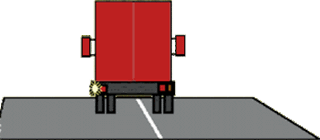
B
C
D
Correct Answer: D
Explanation: A long vehicle may need to swing out in the opposite direction as it approaches a turn, to allow the rear wheels to clear the kerb. Don't try to filter through if you see a gap; as the lorry turns, the gap will close.
Explanation: A long vehicle may need to swing out in the opposite direction as it approaches a turn, to allow the rear wheels to clear the kerb. Don't try to filter through if you see a gap; as the lorry turns, the gap will close.
B
C
D
Correct Answer: A
Explanation: On a motorway, it's best to use a roadside emergency telephone so that the emergency services are able to find you easily. The location of the nearest telephone is shown by an arrow on marker posts at the edge of the hard shoulder. If you use a mobile, the operator will need to know your exact location. Before you call, find out the number on the nearest marker post. This number will identify your exact location.
Explanation: On a motorway, it's best to use a roadside emergency telephone so that the emergency services are able to find you easily. The location of the nearest telephone is shown by an arrow on marker posts at the edge of the hard shoulder. If you use a mobile, the operator will need to know your exact location. Before you call, find out the number on the nearest marker post. This number will identify your exact location.
Correct Answer: C
Explanation: On motorways, reflective studs of various colours are fixed in the road between the lanes. These help you to identify which lane you're in when it's dark or in poor visibility. Amber-coloured studs are found on the right-hand edge of the main carriageway, next to the central reservation.
Explanation: On motorways, reflective studs of various colours are fixed in the road between the lanes. These help you to identify which lane you're in when it's dark or in poor visibility. Amber-coloured studs are found on the right-hand edge of the main carriageway, next to the central reservation.
B
C
D
Correct Answer: D
Explanation: Make sure that you know the speed limit for the road that you're on. The speed limit on a dual carriageway or motorway is 70 mph for cars and motorcycles, unless signs indicate otherwise. The speed limits for different types of vehicle are listed in The Highway Code.
Explanation: Make sure that you know the speed limit for the road that you're on. The speed limit on a dual carriageway or motorway is 70 mph for cars and motorcycles, unless signs indicate otherwise. The speed limits for different types of vehicle are listed in The Highway Code.
B
C
D
Correct Answer: D
Explanation: There's a 30 mph speed limit where there are street lights unless signs show another limit.
Explanation: There's a 30 mph speed limit where there are street lights unless signs show another limit.
Correct Answer: A
Explanation: The purpose of yellow box markings is to keep junctions clear of queuing traffic. You may only wait in the marked area when you're turning right and your exit lane is clear but you can't complete the turn because of oncoming traffic or other traffic waiting to turning right.
Explanation: The purpose of yellow box markings is to keep junctions clear of queuing traffic. You may only wait in the marked area when you're turning right and your exit lane is clear but you can't complete the turn because of oncoming traffic or other traffic waiting to turning right.
Correct Answer: C
Explanation: This sign tells you to beware of trams. If you don't usually drive in a town where there are trams, remember to look out for them at junctions and look for tram rails, signs and signals.
Explanation: This sign tells you to beware of trams. If you don't usually drive in a town where there are trams, remember to look out for them at junctions and look for tram rails, signs and signals.
Correct Answer: C
Explanation: When driving on a motorway or slip road, you mustn't enter an area marked with chevrons and bordered by a solid white line for any reason, except in an emergency.
Explanation: When driving on a motorway or slip road, you mustn't enter an area marked with chevrons and bordered by a solid white line for any reason, except in an emergency.
Correct Answer: C
Explanation: You should change lanes as directed by the sign. Here, the right-hand lane is closed but the left-hand and centre lanes are available. Merging in turn is recommended when it's safe and traffic is going slowly; for example, at roadworks or a road traffic incident. When vehicles are travelling at speed, this isn't advisable and you should move into the appropriate lane in good time.
Explanation: You should change lanes as directed by the sign. Here, the right-hand lane is closed but the left-hand and centre lanes are available. Merging in turn is recommended when it's safe and traffic is going slowly; for example, at roadworks or a road traffic incident. When vehicles are travelling at speed, this isn't advisable and you should move into the appropriate lane in good time.
15. You see a car on the hard shoulder of a motorway with a 'help' pennant displayed. What does this mean?
Mark one answer
B
C
D
Correct Answer: D
Explanation: If a disabled driver's vehicle breaks down and they're unable to walk to an emergency phone, they're advised to stay in their car and switch on the hazard warning lights. They may also display a 'help' pennant in their vehicle.
Explanation: If a disabled driver's vehicle breaks down and they're unable to walk to an emergency phone, they're advised to stay in their car and switch on the hazard warning lights. They may also display a 'help' pennant in their vehicle.
16. You're signalling to turn right in busy traffic. How would you confirm your intention safely?
Mark one answer
B
C
D
Correct Answer: B
Explanation: In some situations, you may feel your indicators can't be seen by other road users. If you think you need to make your intention more obvious, give the arm signal shown in The Highway Code.
Explanation: In some situations, you may feel your indicators can't be seen by other road users. If you think you need to make your intention more obvious, give the arm signal shown in The Highway Code.
17. You're on a three-lane motorway. There are red reflective studs on your left and white ones to your right. Which lane are you in?
Mark one answer
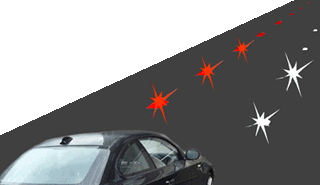
B
C
D
Correct Answer: A
Explanation: The colours of the reflective studs on the motorway and their locations are
- red - between the hard shoulder and the carriageway
- white - between lanes
- amber - between the carriageway and the central reservation
- green - along slip-road exits and entrances
- bright green/yellow - at roadworks and contraflow systems
Explanation: The colours of the reflective studs on the motorway and their locations are
- red - between the hard shoulder and the carriageway
- white - between lanes
- amber - between the carriageway and the central reservation
- green - along slip-road exits and entrances
- bright green/yellow - at roadworks and contraflow systems
18. You're travelling on a road that has speed humps. What should you do when the driver in front is travelling more slowly than you?
Mark one answer
B
C
D
Correct Answer: C
Explanation: Be patient and stay behind the car in front. You shouldn't normally overtake other vehicles in areas subject to traffic calming. If you overtake here, you may easily exceed the speed limit, defeating the purpose of the traffic-calming measures.
Explanation: Be patient and stay behind the car in front. You shouldn't normally overtake other vehicles in areas subject to traffic calming. If you overtake here, you may easily exceed the speed limit, defeating the purpose of the traffic-calming measures.
Correct Answer: B
Explanation: Some modern batteries are maintenance-free. Check your vehicle handbook and, if necessary, make sure that the plates in each battery cell are covered with fluid.
Explanation: Some modern batteries are maintenance-free. Check your vehicle handbook and, if necessary, make sure that the plates in each battery cell are covered with fluid.
20. You're approaching a crossroads. The traffic lights have failed. What should you do?
Mark one answer
B
C
D
Correct Answer: B
Explanation: When approaching a junction where the traffic lights have failed, you should proceed with caution. Treat the situation as an unmarked junction and be prepared to stop.
Explanation: When approaching a junction where the traffic lights have failed, you should proceed with caution. Treat the situation as an unmarked junction and be prepared to stop.
21. You're in a line of traffic. The driver behind you is following very closely. What action should you take?
Mark one answer
B
C
D
Correct Answer: D
Explanation: If the driver behind is following too closely, there's a danger they'll collide with the back of your car if you stop suddenly. You can reduce this risk by slowing down and increasing the safety margin in front of you. This reduces the chance that you'll have to stop suddenly and allows you to spread your braking over a greater distance. This is an example of defensive driving.
Explanation: If the driver behind is following too closely, there's a danger they'll collide with the back of your car if you stop suddenly. You can reduce this risk by slowing down and increasing the safety margin in front of you. This reduces the chance that you'll have to stop suddenly and allows you to spread your braking over a greater distance. This is an example of defensive driving.
Correct Answer: D
Explanation: The white light shows that trams must stop. The green light shows that other vehicles can go if the way is clear. Trams are being introduced into more cities, so you're likely to come across them and you should learn which signs apply to them.
Explanation: The white light shows that trams must stop. The green light shows that other vehicles can go if the way is clear. Trams are being introduced into more cities, so you're likely to come across them and you should learn which signs apply to them.
Correct Answer: A
Explanation: Stop' signs are situated at junctions where visibility is restricted or where there's heavy traffic. They must be obeyed: you must stop. Take good all-round observation before moving off.
Explanation: Stop' signs are situated at junctions where visibility is restricted or where there's heavy traffic. They must be obeyed: you must stop. Take good all-round observation before moving off.
B
C
D
Correct Answer: C
Explanation: Planning your journey before you set out can help to make it much easier and more pleasant, and may help to ease traffic congestion. Look at a map to help you do this. You may need maps of different scales, depending on where and how far you're going. Printing or writing out the route can also help.
Explanation: Planning your journey before you set out can help to make it much easier and more pleasant, and may help to ease traffic congestion. Look at a map to help you do this. You may need maps of different scales, depending on where and how far you're going. Printing or writing out the route can also help.
25. A person has been injured. They may be suffering from shock. What are the warning signs to look for?
Mark one answer
B
C
D
Correct Answer: B
Explanation: The effects of shock may not be immediately obvious. Warning signs are rapid pulse, sweating, pale grey skin and rapid shallow breathing.
Explanation: The effects of shock may not be immediately obvious. Warning signs are rapid pulse, sweating, pale grey skin and rapid shallow breathing.
Correct Answer: D
Explanation: The vehicle excise licence (road tax) can be renewed at post offices, vehicle registration offices, online or by phone. When applying, make sure you have all the relevant valid documents, including a valid MOT test certificate where applicable.
Explanation: The vehicle excise licence (road tax) can be renewed at post offices, vehicle registration offices, online or by phone. When applying, make sure you have all the relevant valid documents, including a valid MOT test certificate where applicable.
Correct Answer: C
Explanation: Be aware that this is just the braking distance. You need to add the thinking distance to this to give the overall stopping distance. At 50 mph, the typical thinking distance will be 15 metres (50 feet), plus a braking distance of 38 metres (125 feet), giving an overall stopping distance of 53 metres (175 feet). The stopping distance could be greater than this, depending on your attention and response to any hazards. These figures are a general guide.
Explanation: Be aware that this is just the braking distance. You need to add the thinking distance to this to give the overall stopping distance. At 50 mph, the typical thinking distance will be 15 metres (50 feet), plus a braking distance of 38 metres (125 feet), giving an overall stopping distance of 53 metres (175 feet). The stopping distance could be greater than this, depending on your attention and response to any hazards. These figures are a general guide.
28. You're involved in a collision. Afterwards, which document may the police ask you to produce?
Mark one answer
B
C
D
Correct Answer: A
Explanation: You must stop if you've been involved in a collision which results in injury or damage. The police may ask to see your driving licence and insurance details at the time or later at a police station.
Explanation: You must stop if you've been involved in a collision which results in injury or damage. The police may ask to see your driving licence and insurance details at the time or later at a police station.
B
C
D
Correct Answer: B
Explanation: A motorcyclist could be riding along the outside of the queue. Always check your mirror before turning, as situations behind you can change in the time you've been waiting to turn.
Explanation: A motorcyclist could be riding along the outside of the queue. Always check your mirror before turning, as situations behind you can change in the time you've been waiting to turn.
B
C
D
Correct Answer: B
Explanation: The flashing amber light allows pedestrians already on the crossing to get to the other side before a green light shows to the traffic. Be aware that some pedestrians, such as elderly people and young children, need longer to cross. Let them do this at their own pace.
Explanation: The flashing amber light allows pedestrians already on the crossing to get to the other side before a green light shows to the traffic. Be aware that some pedestrians, such as elderly people and young children, need longer to cross. Let them do this at their own pace.
31. You intend to turn left from a main road into a minor road. What should you do as you approach it?
Mark one answer
B
C
D
Correct Answer: C
Explanation: Your road position can help other road users to anticipate your actions. Keep to the left as you approach a left turn and don't swing out into the centre of the road in order to make the turn easier. This could endanger oncoming traffic and may cause other road users to misunderstand your intentions.
Explanation: Your road position can help other road users to anticipate your actions. Keep to the left as you approach a left turn and don't swing out into the centre of the road in order to make the turn easier. This could endanger oncoming traffic and may cause other road users to misunderstand your intentions.
Correct Answer: B
Explanation: Driving a vehicle without insurance cover is illegal, so be sure that, whoever's car you drive, you're insured - whether on their policy or on your own. If you need to take out insurance, it's worth comparing several quotes before you decide which insurance provider best meets your needs.
Explanation: Driving a vehicle without insurance cover is illegal, so be sure that, whoever's car you drive, you're insured - whether on their policy or on your own. If you need to take out insurance, it's worth comparing several quotes before you decide which insurance provider best meets your needs.
Correct Answer: C
Explanation: Pull up on the hard shoulder and make your way to the nearest emergency telephone to call for assistance. Don't attempt to repair your vehicle while it's on the hard shoulder, because of the risk posed by traffic passing at high speeds.
Explanation: Pull up on the hard shoulder and make your way to the nearest emergency telephone to call for assistance. Don't attempt to repair your vehicle while it's on the hard shoulder, because of the risk posed by traffic passing at high speeds.
Correct Answer: D
Explanation: If the wheels of your vehicle lock, they won't grip the road and you'll lose steering control. In good conditions, the anti-lock braking system (ABS) will prevent the wheels from locking and you'll keep control of your steering. In poor weather conditions or on loose surfaces, the ABS may be less effective.
Explanation: If the wheels of your vehicle lock, they won't grip the road and you'll lose steering control. In good conditions, the anti-lock braking system (ABS) will prevent the wheels from locking and you'll keep control of your steering. In poor weather conditions or on loose surfaces, the ABS may be less effective.
35. You're travelling along this narrow country road. How should you pass the cyclist?
Mark one answer
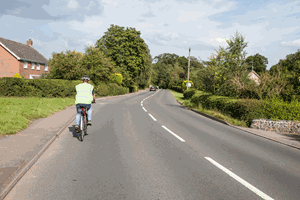
B
C
D
Correct Answer: C
Explanation: Allow the cyclist plenty of room in case they wobble or swerve around a pothole or raised drain. Look well ahead before you start to overtake, because you'll need to use all of the road. Look for entrances to fields where tractors or other farm machinery could be waiting to pull out.
Explanation: Allow the cyclist plenty of room in case they wobble or swerve around a pothole or raised drain. Look well ahead before you start to overtake, because you'll need to use all of the road. Look for entrances to fields where tractors or other farm machinery could be waiting to pull out.
36. Your vehicle is fitted with a hand-held telephone. What should you do to use the phone?
Mark one answer
B
C
D
Correct Answer: B
Explanation: Never attempt to use a hand-held phone while you're driving, except in a genuine emergency. It's illegal and will take your attention away from driving, putting you at greater risk of causing a collision.
Explanation: Never attempt to use a hand-held phone while you're driving, except in a genuine emergency. It's illegal and will take your attention away from driving, putting you at greater risk of causing a collision.
B
C
D
Correct Answer: A
Explanation: If you're driving in high winds, be aware that the conditions might force a motorcyclist or cyclist to swerve or wobble. Take this into consideration if you're following or wish to overtake a two-wheeled vehicle.
Explanation: If you're driving in high winds, be aware that the conditions might force a motorcyclist or cyclist to swerve or wobble. Take this into consideration if you're following or wish to overtake a two-wheeled vehicle.
38. You're driving on the motorway. Well before you reach your intended exit, where should you position your vehicle?
Mark one answer
B
C
D
Correct Answer: B
Explanation: You'll see the first advance direction sign one mile from a motorway exit. If you're travelling at 60 mph in the right-hand lane, you'll only have about 50 seconds before you reach the countdown markers. There'll be another sign at the half-mile point. Move to the left-hand lane in good time. Don't cut across traffic at the last moment and don't risk missing your exit.
Explanation: You'll see the first advance direction sign one mile from a motorway exit. If you're travelling at 60 mph in the right-hand lane, you'll only have about 50 seconds before you reach the countdown markers. There'll be another sign at the half-mile point. Move to the left-hand lane in good time. Don't cut across traffic at the last moment and don't risk missing your exit.
Correct Answer: A
Explanation: All vehicles need to be serviced to keep working efficiently. An efficient engine uses less fuel and produces fewer harmful emissions than an engine that's running inefficiently. Keeping the vehicle serviced to the manufacturer's schedule should also make it more reliable and reduce the chance of it breaking down.
Explanation: All vehicles need to be serviced to keep working efficiently. An efficient engine uses less fuel and produces fewer harmful emissions than an engine that's running inefficiently. Keeping the vehicle serviced to the manufacturer's schedule should also make it more reliable and reduce the chance of it breaking down.
Correct Answer: B
Explanation: When you take your foot off the accelerator, engines have a natural resistance to turn, caused mainly by the cylinder compression. Changing to a lower gear requires the engine to turn faster and so it will have greater resistance than when it's made to turn more slowly. When going downhill, changing to a lower gear will therefore help to keep the vehicle's speed in check.
Explanation: When you take your foot off the accelerator, engines have a natural resistance to turn, caused mainly by the cylinder compression. Changing to a lower gear requires the engine to turn faster and so it will have greater resistance than when it's made to turn more slowly. When going downhill, changing to a lower gear will therefore help to keep the vehicle's speed in check.
Correct Answer: B
Explanation: If you're wearing sunglasses, you should remove them before driving into a tunnel. If you don't, your vision will be restricted, even in tunnels that appear to be well lit.
Explanation: If you're wearing sunglasses, you should remove them before driving into a tunnel. If you don't, your vision will be restricted, even in tunnels that appear to be well lit.
42. You're driving on an open road in dry weather. What should the distance be between you and the vehicle in front?
Mark one answer

B
C
D
Correct Answer: A
Explanation: One way of checking there's a safe distance between you and the vehicle in front is to use the two-second rule. To check for a two-second time gap, choose a stationary object ahead, such as a bridge or road sign. When the car in front passes the object, say 'Only a fool breaks the two-second rule'. If you reach the object before you finish saying the phrase, you're too close and need to increase the gap.
Explanation: One way of checking there's a safe distance between you and the vehicle in front is to use the two-second rule. To check for a two-second time gap, choose a stationary object ahead, such as a bridge or road sign. When the car in front passes the object, say 'Only a fool breaks the two-second rule'. If you reach the object before you finish saying the phrase, you're too close and need to increase the gap.
43. You're driving towards this left-hand bend. What dangers should you be aware of?
Mark one answer
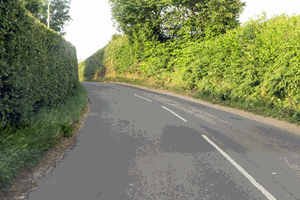
B
C
D
Correct Answer: D
Explanation: Pedestrians walking on a road with no pavement should walk against the direction of the traffic. You can't see around this bend: there may be hidden dangers. Always keep this in mind and give yourself time to react if a hazard does appear.
Explanation: Pedestrians walking on a road with no pavement should walk against the direction of the traffic. You can't see around this bend: there may be hidden dangers. Always keep this in mind and give yourself time to react if a hazard does appear.
44. You're on a motorway. There's a contraflow system ahead. What would you expect to find?
Mark one answer
B
C
D
Correct Answer: A
Explanation: When approaching a contraflow system, reduce speed in good time and obey all speed limits. You may be travelling in a narrower lane than normal, with no permanent barrier between you and the oncoming traffic. Be aware that the hard shoulder may be used for traffic and the road ahead could be obstructed by slow-moving or broken-down vehicles.
Explanation: When approaching a contraflow system, reduce speed in good time and obey all speed limits. You may be travelling in a narrower lane than normal, with no permanent barrier between you and the oncoming traffic. Be aware that the hard shoulder may be used for traffic and the road ahead could be obstructed by slow-moving or broken-down vehicles.
Correct Answer: B
Explanation: Third-party insurance cover is usually cheaper than comprehensive cover. However, it doesn't cover any damage caused to your own vehicle or property. It only covers damage and injury you cause to others.
Explanation: Third-party insurance cover is usually cheaper than comprehensive cover. However, it doesn't cover any damage caused to your own vehicle or property. It only covers damage and injury you cause to others.
46. Your vehicle catches fire while driving through a tunnel. It's still driveable. What should you do?
Mark one answer
B
C
D
Correct Answer: A
Explanation: If it's possible, and you can do so without causing further danger, it may be safer to drive a vehicle that's on fire out of a tunnel. The greatest danger in a tunnel fire is smoke and suffocation.
Explanation: If it's possible, and you can do so without causing further danger, it may be safer to drive a vehicle that's on fire out of a tunnel. The greatest danger in a tunnel fire is smoke and suffocation.
47. What can result when you travel for long distances in neutral (known as coasting)?
Mark one answer
B
C
D
Correct Answer: D
Explanation: Coasting is the term used when the clutch is held down, or the gear lever is in neutral, and the vehicle is allowed to freewheel. This reduces the driver's control of the vehicle. When you coast, the engine can't drive the wheels to stabilise you through a corner, or give the assistance of engine braking to help slow the car.
Explanation: Coasting is the term used when the clutch is held down, or the gear lever is in neutral, and the vehicle is allowed to freewheel. This reduces the driver's control of the vehicle. When you coast, the engine can't drive the wheels to stabilise you through a corner, or give the assistance of engine braking to help slow the car.
48. After passing your driving test, you suffer from ill health. This affects your driving. What must you do?
Mark one answer
B
C
D
Correct Answer: C
Explanation: You must tell DVLA (or DVA in Northern Ireland) if your health is likely to affect your ability to drive. The licensing authority will investigate your situation and then make a decision on whether or not to take away your licence.
Explanation: You must tell DVLA (or DVA in Northern Ireland) if your health is likely to affect your ability to drive. The licensing authority will investigate your situation and then make a decision on whether or not to take away your licence.
Correct Answer: B
Explanation: You must use dipped headlights when daytime visibility is seriously reduced, generally to 100 metres (328 feet) or less. You may also use front or rear fog lights, but they must be switched off when visibility improves.
Explanation: You must use dipped headlights when daytime visibility is seriously reduced, generally to 100 metres (328 feet) or less. You may also use front or rear fog lights, but they must be switched off when visibility improves.
50. When is it acceptable for a passenger to travel in a car without wearing a seat belt?
Mark one answer
B
C
D
Correct Answer: A
Explanation: If you have adult passengers, it's their responsibility to wear a seat belt, but you should still remind them to use one as they get in the car. It's your responsibility to make sure that all children in your car are secured with an appropriate restraint. Exemptions are allowed for those with a medical exemption certificate.
Explanation: If you have adult passengers, it's their responsibility to wear a seat belt, but you should still remind them to use one as they get in the car. It's your responsibility to make sure that all children in your car are secured with an appropriate restraint. Exemptions are allowed for those with a medical exemption certificate.
These 15 mock tests cover the entire 2022 official DVSA revision bank. Like the real theory test, each mock is 57 minutes long and the pass mark is 43 out of 50. Questions are randomly selected from 14 topics. You also have the option of practicing in “test view” which closely resembles the real theory test.
There are 14 topics which you must cover when preparing for your driving theory test. Below are mock tests for each topic.
As of 28 September 2020, three out of the 50 questions in your theory test will be based on a short video clip. Below are 9 video clip tests for you to practice with.
As of 28 September 2020, case studies were removed driving theory test. However, we have retained them for you to practice with.



